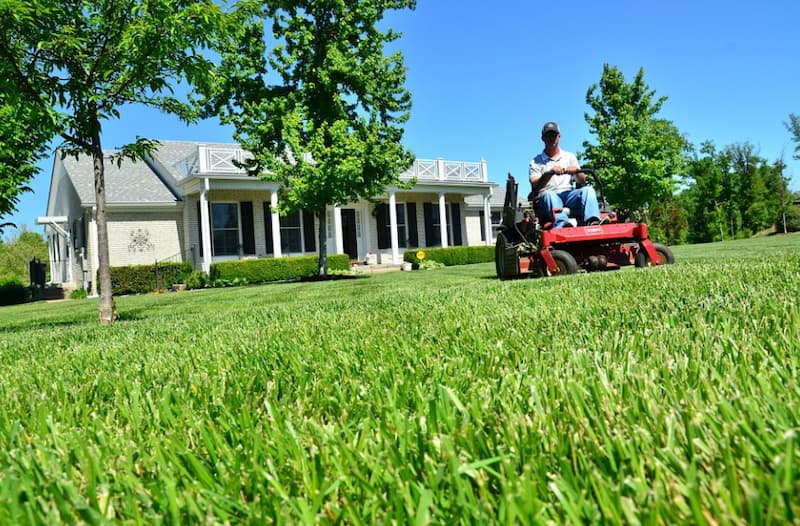Your cart is currently empty!
Sansevieria makes a Very Adaptable Houseplant
Sansevieria is one of the most easily recognized plants in the world. The snake plant makes an excellent potted plant indoors or outdoors.
Your cart is currently empty!
Fall lawn care will help to make sure it is in tip-top shape for the coming winter. While many residents assume spring is the time to focus on your lawn, there are many things you can do to keep your grass strong and healthy during a frigid winter.
It’s important to start it as soon as possible. If you wait until the first cold snap, your chances of success are lower and the work will be more labor-intensive. As soon as the weather starts to turn, begin preparing your lawn for winter.
Late summer is the prime time for applying fertilizer. It will give your grass the nutrients it needs to get through the long cold winter ahead. If you fertilized in spring, at least three months should have passed since then. This gives the lawn a chance to absorb as much fertilizer as it can before growth stops.
If you haven’t used any fertilizer yet this year, make sure to pick up some early fall lawn care products. There are a variety of brands that are very affordable and easy to use. Just spread them evenly across your entire lawn after mowing and water lightly afterward. Make sure to read instructions carefully so you know how much of each product your lawn needs and when they should be applied.
If you haven’t been mowing your lawn in the fall, you’ve been packing the lawn mower away too soon. When leaves begin to fall, it’s important for them to be removed from the lawn as soon as possible or they will dry out and form a layer on the surface of the grass that will make cold weather much more damaging.
For best results with fall lawn care, use a mulching mower. This type of mower chops up leaf matter into tiny pieces so that it falls between grass blades rather than building up on top of the grass. You can also try raking your lawn, but this can take a very long time and can wear you out quickly if you have a large yard with lots of leaves.
Most importantly: Don’t forget to water your lawn. Mulching mowers typically allow the grass to dry out faster than non-mulching types, so you’ll need to water more often if you’re using a mulcher. It’s best to do this in the evening or early morning – before the sun has a chance to evaporate all of the moisture from your lawn.

Source: https://pixabay.com/photos/lawn-care-lawn-maintenance-643556/
Depending on where you live will determine your lawn’s water needs during the fall. If you live in a humid area, your lawn may still be actively growing and thus need to be watered frequently to help the grass fight off any disease or pests that might try to take advantage of it while it’s vulnerable. In other areas, fall is a very dry time of year and watering will only encourage fungus growth.
The best solution is automated irrigation. This will allow you to set up a timer so that the sprinklers come on when they’re needed most. It also lets you know if something is wrong with your system and keeps your lawn looking neat without requiring constant maintenance by yourself.
It’s important to remove excess thatch as part of your fall lawn care. This will help prevent fungus growth in those areas where grass and soil meet. It also allows more air, water, and fertilizer to penetrate deep into the ground. You can do this by renting a dethatching machine or hiring someone else to come out and do it for you. If you rent the machine yourself, make sure to follow all of the manufacturer’s instructions carefully so that you get an even depth when removing thatch.
It’s important to make sure your lawn is ready for the coming winter, but it can be hard to find the time and energy during such a busy season. Fortunately, there are many ways you can prep your lawn before the first frost hits that can be done quickly and can make a big impact come spring!
Shannon Quantock is a real estate writer at House Stories. She loves writing on Real Estate, Gardening and Finance. Her goal is to keep content as simple as possible for readers to understand.
Sansevieria is one of the most easily recognized plants in the world. The snake plant makes an excellent potted plant indoors or outdoors.
Celery has a reputation as one of the most daunting vegetables to grow. But understanding conditions celery likes, it’s an enjoyable crop.
Share gardening tips for spring care & pruning advice with fellow gardeners! Learn how to prune roses, care for forsythia shrubs, and pollinate with Daphne! Get ready for a backyard full of colour and buzzing bees!
Introduced species become invasive in areas lacking their natural pests, diseases, and predators. Biological controls can fail without proper precautions.
Planning your garden for the next season can add to the joy of gardening. Planning allows new ideas and accentuating what worked well.
Here is a list of basics steps in gardening. The more natives you incorporate into your garden, the happier flora and insects will be.
GardeningCalendar.ca gets some funding from advertisers. If you click on links and advertisements at no cost to you, the site may receive a small commission that helps fund its operation.
© 2025 J&S Calendars Ltd.
Leave a Reply
You must be logged in to post a comment.